|
The Lone Badger posted:What happens if you obtain the gem before dealing with the throne room and wave it in Soth's face inside the dreamworld? The author really didn't think of that option. DM's discretion, but it should work .. maybe? Soth is aware that these are fantasies, but he's sort of stoned out and his ability to think is limited due to splitting himself between the six mirrors. Also, Sithicus is supposed to be rapidly disintegrating so a thorough search might be difficult.
|
|
|
|

|
| # ? Apr 26, 2024 03:15 |
|
The Lone Badger posted:What happens if you obtain the gem before dealing with the throne room and wave it in Soth's face inside the dreamworld? Figure in Mirrors 1 - 5 he won't recognize it and in Mirror 6 that won't work because it's a physical object that your current form can't hold. And even if you could, Soth will believe that it's a fake and that he has the real gem. The point is that you need to bring Soth and his full attention back to the "real world" of Sithicus (by loving up his "holodeck" adventures) if you want to resolve the adventure (AKA not get stuck in a disintegrating realm). One interesting indication about Soth's real relationship with Kitiara can be gleaned from the two times you can actually interact with her in the mirror realms. Both times you'll note that she's in a position of power over him, both in terms of Level and authority (once as a judge and the other as a Dragon Highlord). In the reality of Krynn, she was never his "girlfriend." She was basically his boss and he was one of her chief minions. Their real relationship was probably closer to what Soth has with Azrael the werebadger Dwarf - except that in this case, Soth was Azrael.
|
|
|
|
So this whole thing is basically him having a crush on his boss? Darklords being failed/post-script campaign villains or lieutenants might explain a lot. Could work well as a stealth followup campaign showing what happened to a particularly memorable campaign villain.
|
|
|
|
One combat round in AD&D lasts one minute, but that also takes into account jostling for position, feints and parries, and reading The Deck of Encounters Set Two Part 38: The Deck of Hatoris and Horror 192: Shifting Sands The PCs are hired to check out what happened to a caravan that was going along a well-travelled desert road and never arrived. They find the caravan camped as if at a rest stop, but nobody’s there. Then they’re attacked by five lesser hatoris from beneath the sand. Congrats, it’s a boring quest! Actually it’s marked as a desert encounter, so it would be perfectly usable even if you dropped the quest angle - it’s just that it’s a boring combat so I don’t care about it. I appreciate seeing monsters that I’ve never given a single thought to before in my life, though. 193: Vengeance Is Mine The PCs are in an inn, and the serving girls are refusing to go down in the basement because they say it’s haunted. The patrons taunt the innkeeper about it and treat it as a joke, but the innkeeper himself seems serious. He eyes the PCs, leads them to the back, and offers them a reward to get rid of the ghost that’s haunting the inn. When he leads them downstairs, a female PC or one standing next to the innkeeper will be possessed by the haunt of a serving girl he murdered two weeks earlier, who will try to avenge her death. Well, if you’re going to have a murdered woman in your random encounter, you may as well let the woman murder the dude back. A little too dark for me in my elfgame random encounter, though, so pass. 194: Where There’s Smoke, There’s Fire The PCs are going through caverns on the way to “the main dungeon” and enter a chamber with various tunnels branching off in a specific arrangement that I don’t care much about. The point here is that they’re going to get ambushed by hell hounds from all directions. (Eight of them.) An interesting mechanical note is that all the PCs smell something, but can identify that something as sulphur on an INT-10 check. But that’s completely superfluous die-rolling, because no matter what, “By the time they have identified the smell, two hell hounds block the main passage.” It’s a “monster attacks” encounter and it’s not great, but in my experience dungeoneering PCs very rarely get flanked or surrounded, and that’s interesting tactical space. Keep. 195: This Old House There’s a large manor-type house in a mountain pass. That’s unusual. It and the fields around it are in disrepair. A man “dressed as a warrior” but with no weapon appears at the doorway and invites them to accept his hospitality and stay for the night. The inside is dusty and everything seems unused. And if the PCs sleep in the beds they will totally be attacked by the host and nine other heucuva in the middle of the night. I would say “give this guy a name and a fake backstory,” but this is all so clearly sketchy that making him vague and evasive about himself hardly makes him any more suspicious. If the PCs still stay the night at that point... well, they knew what they were getting into. Keep. Probably add some treasure, too. 196: Sinking Ship The PCs are hurrying somewhere, so they hired a quick-looking ship that’s leaving immediately. They’re asked to stay in a little cabin under the deck. But the ship starts rocking badly and the whole thing overturns. They need to escape the rapid-ly filling ship and are stranded in the middle of the ocean. “Soon they must drop their gear or sink. Just as they are losing strength, they are approached by several hippocampi. To survive, they must convince the hippocampi to allow them to ride to safety on their backs.” Which shouldn’t be hard, because the DM isn’t going to be that much of an rear end in a top hat, right? And also they’re good-aligned, and saving drowning good people is pretty much their whole deal? I’m not going to wreck the PCs’ ship for such a boring encounter. Pass.
|
|
|
|
Ghost Leviathan posted:So this whole thing is basically him having a crush on his boss? I think Soth was more powerful than Kitara individually however. MonsterEnvy fucked around with this message at 21:46 on Aug 16, 2020 |
|
|
|
Age of Sigmar Lore Chat: Kharadron Overlords Big Bote  An Arkanaut Ironclad is the heaviest warship the Kharadron have devised, a massive and intimidating ship of the line with enough guns to level a city. (Assuming the city doesn't defend itself, anyway.) They are covered in gun placements and torpedo tubes, which can fire at devstating speeds. These are the solid heart of the Kharadron fleets, and by far the largest war vessels routinely seen in them. They are not the biggest warrships that exist, however. Battleships and gunship carriers exist that dwarf them, but each of those is a unique design, too expensive to be mass produced and too fuel-inefficient to be worth fielding very often. The Ironclad balances offensive power and aether-gold consumption at a ratio that has yet to be beaten. An Ironclad is also notably smaller than most of the unarmed mining and cargo vessels the Kharadron use, but those are more empty space to store goods in than anything. A single Ironclad still isn't cheap - they may be able to be produced on a mass pattern, but there's a lot of money that goes into each one. Thus, they are built to last and to operate efficiently. Their cargo holds must be large enough to store a good supply of aether-gold, and their bunks must accomodate a large complement of Arkanauts or Thunderers. They have to be able to remain in operation for upwards of a year of active duty, though it's expected that they will be maintained and their reinforced hulls repaired by the on-ship Endrinmaster. They are designed to take a heavy punishment before they go down...but even so, it is a truism among Endrineers that the best defense is overwhelmingly powerful offense. Enter the Ironclad weaponry. Bow-mounted swivelyguns fire solid-shot projectiles at anyone that gets close, and the torpedo tubes are filled with aethershock torpedoes that fly on their own miniature jet-endrins until they reach their target and explode. Each ship is also heavily equipped with grudgesettler bombs to take out ground-based targets. However, all of these pale in comparison to the Ironclad's main weapon, mounted on the forcastle. There are three weapons commonly seen in this capacity - a great sky cannon to fire off powerful blasts, a great skyhook to smash large foes out of the sky, or a great volley cannon to focus on smaller foes with hails of aethershot. Endrinriggers are an airborne troop found alongside any Ironclad, working to keep it going. They are one of two types of Skyrigger soldier, both of which are defined by their bulbous aether-endrins that allow them to race through the air and their mag-boots and skyhooks that let them hitch onto the airships to conserve fuel. In battle, they detach from the hull and work as rapid-response teams charged to maintain the ships at top capability. They are junior endrineers that report to afleet's Admiral and Endrinmaster. To achieve higher rank in their guild, they must perform feats of daring that prove their skill and competence in battle, and so they are often found moving through great danger to reach damaged vessels for field repairs. Their repair tools double as weapons - their rivet pistols are as capable of piercing flesh as steel, and their aethermatic saws can cut bone with equal ease. Some even rely on grapnel launchers to drag foes out of cover so they can be shot down more easily. The Skywardens are the other kind of Skyrigger troops. They aren't mechanics - they're aerial shock troopers. They move in from the air to disrupt enemy formations and strike key targets, then fly away before anyone can react. To make their work easier and to kill more of the enemy, they are equipped with skymines and timed explosive charges, making it very hard to pursue them even if you can also fly. Skywardens use vulcaniser pistols as their main weapon - short-ranged guns that fire superheated aether which can melt even the strongest armor if subjected to concentrated fire. For melee, they use skypikes - aether-powered spears taller than their wielders, which enhance the strength of the blows they strike.  The Arkanaut Frigate is the mainstay of the Kharadron fleet, the pinnacle of centuries of development and refinement by the Endrineers Guild. It balances power, speed and transport capacity to allow it to fill many roles. It's faster than most monsters in the air, but still powerful enough to escape the clutches of the density holes that plague Chamon's skies. The cargo holds are small compared to those of an aetherhulk transport or cloud-dredger, but the frigate is much faster and more well-armed. (And, you know, armed at all.) Only an Ironclad can boast greater firepower, of all the ships built by the sky-ports. A Frigate's main gun is mounted on a turret on the foredeck, and it can either serve as a sky cannon for clearing out enemy troops or a skyhook, launching a large harpoon at bigger targets. Below the main deck, bow-mounted turrets have aethershot swivelguns, and like an Ironclad, a Frigate will also carry a number of grudgesettler bombs, both of which allow clearing out of bunched up ground targets with ease. If enemies attempt to board, the crew can release detonation drills, miniature flying drills that explode in a chain of blasts to take out boarders. Against aerial threats, it can deply skymines, driving the foe back in a hail of explosions. The Frigate is found in use throughout the skies - it is the most common patrol ship in Kharadron airspace, and for smaller trade missions it may serve as a cargo hauler. For larger ones, they're more often seen as armed escorts. Frigates can also work in small-scale mining operations to siphon and transport raw gas, but for bigger ones it is used exclusively in a guard role, as it is first and foresmost a warship. In breaking the siege of Barak-Zon, Frigates from all sky-ports formed a massive battleline, launching enough firepower to smash the magical chain capturing the city and tearing apart the daemonic hordes that had placed it in a light show that the locals of the Kharzdon Mountains had never seen before or since. At Grimlock pass, three Frigates proved able to hold the position against Waaaagh! Ironteef, blunting the orruk invasion before it could begin and saving several key trading posts. As yet, the orruks have not dared mount a second attack. Aerial power, of course, is insufficient to seize and hold territory. That's what the Arkanaut Companies are for. These sailors are trained both to crew the vessels and to fight as marines, hurtling out of the ships on grav-ladders and suspension ropes to deploy into battle in the blink of an eye. They are usually armed with pistols and axes, operating with a strategy of using ranged fire to thin out the enemy before they finish the job in melee. However, a few Arkanauts per squad are designated to bear heavy weapons. Skypikes, for example, are excellent for clearing out foes in melee, while an aethermatic volley gun can unleash a lot of bullets in a very, very short time. They also have been known to carry portable skyhooks to bring down large targets. Arkanauts tend to be tough bastards, spending entire wind cycles at a time aboard their ships. They need to be ready for any kind of air conditions, and a pleasant voyage can turn dangerous very, very fast between bad weather and aerial attackers. Even their armor is insufficient to keep out the wind, and so most Arkanauts end up developing skin toughened by the metallic gases that flow in the clouds of Chamon. Their helms have special masks and rebreathers to filter out toxic gases, at least, so it's survivable. They are trained to keep an eye out for the shimmer of aether-gold or the specks of enemies on the horizon. Despite the dangers, there's always more city duardin eager to join the Arkanauts - it's one of the best and most reliable ways to become rich and powerful. In the early years of the Sky Exodus, the fleets tended to be crewed by specific clans, but since the Code was established, clan membership has largely been forgotten. The Arkanauts are not bound by blood - they are bound by the shared knowledge that they are the best and boldest of the Kharadron. In Brynruf, the time of year when the sun of Chamon shines gold, each Arkanaut academy of each skyport holds a massive six-day competition. Only those who succeed at these competitions may join the academies as students, where veterans of the fleet train them in military drills and aeronautics. On these Musterpress days, students will also drill and take part in competition so that captains can observe them and make judgements on their skills. These captains can recruit new crew members by purchasing their contracts, usually to fill places left open by death or injury. These new Arkanauts must endure whatever rites or rituals are considered sacred by their new fleet and/or ship, but are accepted as the best. Those who have passed over after three full Musterpresses no longer have the chance to join the Arkanauts, and typically must find work on mining vessels, fishing ships or as dockworkers. While most ships are known largely to their own crew and fleet, a few become famous among the Kharadron for their deeds, changing history through the skill of their captains and crews. These are the tales that inspire would-be Arkanauts. The most famous is certainly the Frigate Nazgrund, literally "Cloudhammer," which was the flagship of Horgrumm Brand, first of the Grand Admirals. At the time of the Code's formation, it was the most cutting-edge ship in existence, and it led the Battle of the First Coalition to defeat the Tetronomicar, the three Daemon Princes that had pursued the sky-fleets ever since they fled their mountain cities. While Admiral Brand plotted the strategy that won the day, he died in that battle, his body turned to pure silver by a spell from a Lord of Change. To honor him, his body was turned into the Nazgrund's figurehead. It had many captains and admirals over the centuries since, until it was finally retired and installed as a museum piece in the Ancestor's Plaza of Barak-Nar. Rumor has it, however, that BArak-Nar's Endrineers Guild has outfitted the thing with the latest endrins and weaponry in case it will be needed once more. Barak-Zon, meanwhile, sings the praises of the Rhyngul Vengryn, literally Redmetal Vengeance, which is the flagship of Grund Tahlihro, the Master of the Outer Airs. Barak-Mhornar's alehalls ring with songs of Zayn Reggson and his Ironclad, Night's Gift. Barak-Zilfin remmebers the frigate Trailblazer, which Admiral Ebbrig Ahl-Kalim used to map more sky-lanes than any other port has ever seen. Next time: The Grundcorps
|
|
|
|
Young Freud posted:I was thinking about how to do this like a Fate-style trait, like a character receives bennies or fate points or what have you if they flirt or hit on someone and maybe get a bonus if the target character actually reciprocates. Trying to rack my brain for how this archetype typically acts and it's a mix of doing things for free or cheap for women ("The dame couldn't pay much, but I couldn't let a case like hers go unsolved..."), being unable to walk away or cut their losses when a woman is involved (typical protagonist stuff), and exposing themselves to danger by thinking the best of women, underestimating them, and/or thinking with their dick ("I wasn't sure she wasn't the one who'd put her husband six feet under, but she was wearing a low-cut dress, so despite the smell of bitter almonds rising from the cocktail she'd handed me, I took a sip."). The more comical side of the archetype has them get themselves pulled into a lot of zany schemes because of this (a comical reframing of the willingness to do anything for a woman), being ludicrously suggestible whenever a woman is involved (a comical reframing of the patronizing tendency to not see women as threats), and having a string of former flings and affairs that complicate things. I'd probably divide it into four categories: 1) When negotiating something like a price, the Lustful character always acts at a disadvantage towards opportunistic targets of their desire. 2) The Lustful character leaves themselves vulnerable to attacks from targets of their desire. Giving someone a Fate Point for drinking the cyanide would fit in here. 3) The Lustful character makes plots centered on themselves happen. To use GURPS terms, they have Allies, Dependents, and Enemies that appear from time to time, acting as plot hooks. This is in many ways not a disadvantage or flaw, but an advantage, because it puts the spotlight on the Lustful character. 4) The Lustful character can push themselves to accomplish something for targets of their desire. This too is an advantage rather than a disadvantage, since it allows the Lustful character to accomplish more.
|
|
|
|
MonsterEnvy posted:I think Soth was more powerful than Katara individually however. 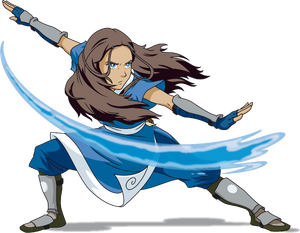 Wait, did I miss something?
|
|
|
|
Falconier111 posted:
You dodged a typo. 
|
|
|
|
Age of Sigmar Lore Chat: Kharadron Overlords Small Bote While much of the Kharadron military is handled by the Arkanaut crews that fly the ships, it's not all of them. Because they must be both sailor and soldier, the Arkanauts are not an elite force. That role is embodied in a single name: the Grundstok Company, or Grundcorps. This corporation has been part of Kharadron society for a very long time, and their service is received in exchange for a formal charter and share in the profits of any fleet that hires them. Grundstok forces are highly trained, and often come with their own escort fighters. Grundcorps was founded shortly after the Sky Exodus began, and it has grown with the Kharadron civilization. There are now Grundstok training academies in all major sky-ports and several minor ones. Their founder, Belegrimm Grundstok, set forth their mission centuries ago, when all they did was train sharpshooters: kazar valrahnk. "Protect with honor." The core of Grundstok business rests on the back of the Grundstok Thunderers, elite marksmen trained to defend positions and ships against boarders and attackers. They are equally comfortable aboard ships or on the ground, and when not hired out, they train and drill nearly constantly. Grundstok holds its graduates to exceptionally high standards of discipline and marksmanship. A Grundcaptain, as their unit leaders are called, need only speak a single word to have the entire unit wheel, aim and fire in lightning-fast lockstep. The precision and synchronicity of their guns means that when they fire, they often become impossible to see just due to the light of the gunfire. Grundstok Company pays a premium for its weapons and armor - the Thunderers must have only the best. Their aethershot rifles use hypercharged aether as a projectile, condensing it into a solid form mid-flight. Because they don't need to reload often, they get a massive rate of fire without sacrificing power. A few Thunderers receive heavy weapons to supplement the line of guns. Aethercannons are similar to an aethershot rifle, but are much heavier and much, much higher caliber. Alternatively, a unit may have an aetheric fumigator, which fires clouds of poisonous fumes, or a multi-barrel decksweeper that fires sprays of aether-grain shot. These last two are more specialized in repelling boarders or fighting in tightly packed quarters. When assaulting positions, they instead favor the Grundstok mortar, which fires an aarcing shell that explodes in brilliant aetheric energies. Typically, a Grundstok Thunderer unit will also include an Honor Bearer, a veteran who carries an ancestral standard that bears the record of the unit's entire military history. Often this goes back generations. Most units also keep a mechanical bird called a drillbill as a mascot, honoring the original machine-pet kept by the company founder. Thunderers usually work aboard Arkanaut Frigates and Ironclads, relying on the ship's mobility in battle to deploy wherever their employers require. They're famous for arriving just in the nick of time to turn the tide of battle, and their pride in their skill and history is immense. Grundstok marines are more than capable of reciting their own virtues for hours...and also prone ti criticising the marksmanship and combat skills of the Arkanauts around them. This does cause friction, but the Arkanauts often put up with it after they see what the Grundcorps is capable of in battle, especially because they know none of the Thunderers have any idea how to manage a ship. That task is left to the pilots of the Grundstok Gunhaulers, some of the fastest military vessels known to the Kharadron. Each Gunhauler has a crew of only two duardin, and the entire ship is designed to be light, fast and extremely maneuverable despite having only a single endrin. The Gunhaulers do not belong to Arkanaut fleets and are not ships of the line; they are specialized fighters that are wholly owned by the Grundstok Company. Their job is usually to protect the fleet they're hired on to as escorts, much like the Thunderers are. Their small size makes them more nimble and faster than the larger ships they guard, and while their guns are not so impressive, they are more than able to provide fire support for heavier ships or proactively seeking out the enemy for strafing runs. Gunhaulers operate under direct command of whatever Admiral hires them. When used offensively, they are typically found as strike vessels seeking out specific single targets to eliminate. They dart around the field quickly, blasting their victim with sky cannons and armor-piercing drill rounds and then flying away with shocking agility. When used as escorts, they move more slowly, but no less ably. Gunhauler pilots are taught the key importance of keeping their charges safe, because the reputation (and therefore profit) of the companby depends on them doing so. A Gunhauler is expected to use its speed to interdict foes and, if necessary, sacrifice themselves to absorb incoming attack. This less suicidal than it sounds - the Gunhaulers are small, but they're surprisingly tough little ships and can usually limp away after taking a nasty hit. Their ability to divert power to their endrin and soar over the battlefield to reposition helps in the survival rate as well as giving them chances to come back for flanking attacks.  The End What do you want see next? Again, the options are: Order: Cities of Sigmar, Daughters of Khaine, Fyreslayers, Idoneth Deepkin, Seraphon, Sylvaneth Chaos: Beasts of Chaos, Blades of Khorne, Disciples of Tzeentch, Hedonites of Slaanesh, Maggotkin of Nurgle, Skaven, Slaves to Darkness Destruction: Gloomspite Gits, Ogor Mawtribes, Orruk Warclans Death: Flesh-Eater Courts, Legions of Nagash, Nighthaunt, Ossiarch Bonereapers
|
|
|
|
Seraphon. The Kharadron were less dull than the Stormcast, I say let's see what became of the lizardmen.
|
|
|
|
Orks.
|
|
|
|
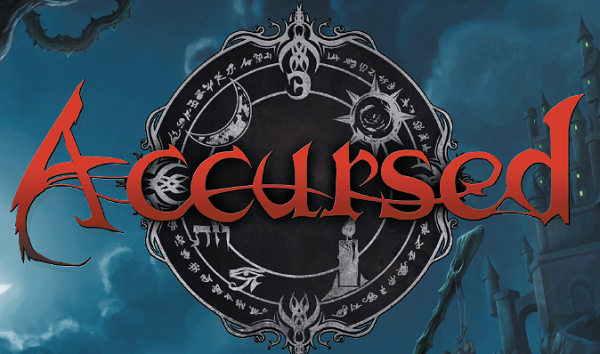 Chapter 1: The Land of Morden (Cairn Kainen, Hebron, Hyphrates) 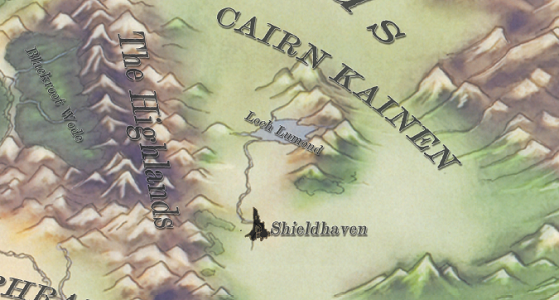 Caer Kainen was a land of hills, mountains, and fiercely independent clans. These clans lived in their villages and mountain strongholds, raising sheep, raiding each other, and cultivating one of the greatest artistic traditions in Morden. While they were known for the cunning of their irregulars and the ferocity of their berserkers, the Kainenites were better known for their skillful bards, elaborate tattoos, and a colossal weeklong festival called the Harvestmoon. They traced their history to the diplomat and dragonslayer High King Bran MacLir, the greatest culture hero in all Morden, and his descendants ruled their kingdom wisely from the great citadel-city Shieldhaven until the Bane War. When the Witches swept into the Outlands, High King Gaelen was among the first to act; he rallied the clans immediately and prepared to go to war. Except shortly after preparations began, an Outlander refugee and noblewoman named Macha appeared at the Royal Court, increasingly drawing Gaelen’s attentions away from the tasks his throne demanded. Soon enough, orders from the capital stopped coming entirely; the clans turned back against each other with no one to adjudicate their disputes even as the soldiers drilled in anticipation of any command. Then news arrived from Shieldhaven. On the night of the new moon, the king had gone mad: suddenly implacable and invincible, he had single-handedly slaughtered the city’s entire population, including the land’s brightest leaders and his own wife and children. Soon enough more news arrived, this time brought by ravens; Lady Macha was in fact a Witch called the Morrigan, and after bewitching the king she had seized the throne.  The Morrigan filled a unique role among the Witches. Every dead human she could access would be placed in an ancient artifact called the Dark Cauldron; most would emerge as mindless walking corpses called cauldronborn, while a few would crawl out with their minds intact as Revenants, the Morrigan’s Accursed (also known as Witchmarked or Witchbreed). They formed the base of the Grand Coven’s armies. By the time the war finally ended, two of Caer Kainen’s six great clans and many of their smaller rivals had gone extinct, almost a third of the nation was either dead or cauldronborn, and Kainenite culture had been shattered beyond repair. The Morrigan set up a new court in the Blackroot Wode to the west and issued three proclamations to her new subjects; first, any command she issues must be obeyed without hesitation; second, all clans must send a number of their members to her court as tribute every season; and third, anyone who fails to obey those two orders would see themselves and their immediate families thrown into the Cauldron. These orders remain in place today, and Cairn Kainen (as it’s come to be known) is almost a grim parody of its former self. Once, hospitality was a high virtue; today, clanholds only rarely open their doors to strangers. Once, clan feuds were held in check by the King; today, they kill each other even as the Morrigan drains their population and enlist travelers in their petty wars. Once, every person able would gather every year for a full week of Harvestmoon celebrations; today, decades have passed since the festival was last held. The population declines more every year and the clans inch closer to destruction. But the wind is shifting. These days, the Morrigan spends most of her time in the western forest, recreating some lost fairytale kingdom with Revenant knights and her Horned King at her side. Her ravens still carry her decrees, but they appear less and less often and her punishments for disobedience grow erratic and delayed. Her hold over the Revenants beyond her sight has slipped so far that they are escaping her control enough to inure the clans to the site of friendly walking corpses. Her hold over the kingdom remains strong, but it frays at the edges and the clans grow restless. Soon enough Cairn Kainen will likely be forced to choose between death by a thousand cuts or risking it all by rebelling. 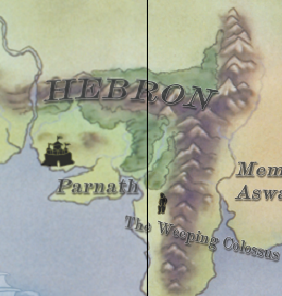 Pardon the line, the map spans a page break and I had to edit two pictures together. Hebron was a small, peaceful, happy nation before the Bane War. Half its population lived in kibbutzim, communal and egalitarian farming communities in which life was part hard labor and part lively debate; their cities, including Parnath (the capital and possibly the most economically important city in Morden), were bustling commercial and intellectual centers whose citizens’ lives were part commercial endeavor and part lively debate. They treasured debate enough that, once the Witches crossed the mountains, they acknowledge the threat and then foisted responsibility off on to the military while they debated domestic matters; and when the Grand Coven’s armies marched into the country, the government deadlocked, unable to convince itself of a course of action. Then Gen. Gideon bar Heshet mounted a coup and put the military in power. He ran roughshod over the law, violently put down resistance, and conscripted entire communities, but the army he built proved pound-for-pound the toughest in Morden. The Crone, the Witch tasked with conquering Hebron, was the Coven’s unofficial leader and most powerful member, but they held the line against her until the Great Betrayal in the Summerlands ended the war and the Crone vanished without explanation. Her armies collapsed and the other Witches ignored the country. It was the only nation to drive out the Witches. Hebron had won.  Modern Hebron is a grim military dictatorship, still firmly under bar Heshet’s control despite the lack of immediate conflict. The entire country suffers from an ongoing identity crisis; while the Witches still lurk beyond the border and bands of Banes and former mercenaries hold parts of the countryside, the constant war footing has begun to permanently damage the nation’s economy – not to mention their ancient identity and values. But bar Heshet, an autocrat by nature, cares little for anything except war and ignores advice he doesn’t want to hear. His supporters point to the aftereffects of the war he saved them from to justify his decisions: they point at Repentance Road, the main road to Parnath, whose sides are coated in the cast-off treasures and graves of those seeking safety in its walls; the former mountain fortress of Matzeda, besieged for a decade before its garrison committed suicide to deprive the Crone of the pleasure of killing them; or to the Weeping Colossus, an ancient statue once rumored to shed a single tear for every Hebronite killed in war and which now stains its base red with constant bloody weeping. His opponents point to the economic damage his refusal to demobilize his massive army causes or his contempt for any civil authority – when they think his partisans won’t hear. Those such things are only barely whispers now, Hebron, after avoiding conquest, might soon collapse into civil war. 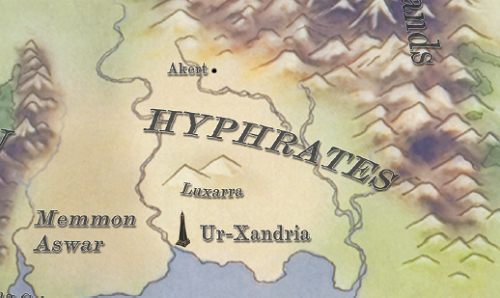 Hyphrates was the first land settled by humans in Morden; at that point a massive series of lush river valleys, its new inhabitants soon built the first city in Morden, Ur-Xandria along the mighty Iteru River. The region quickly fell under the control of Ur-Xandria and its pharaohs, absolute rulers regarded as divinities on earth. They established a massive and stable but deeply depersonalizing state kept in line by mystery cults that drew on hallucinogens. Its populace escaped their hopeless, grinding lives by performing religious ceremonies, private or public, that used drugs to reach the other world or simply to experience something different. Hyphrates became an empire in stasis. It didn’t help that in the early days of the nation, a pharaoh named Onuris had managed to contact the Djinn herself and challenge her to a game of chance; Onuris wagered control over his nation, and the Djinn offered a single wish to every member of his line. Onuris won, to her chagrin, and since she both offered tremendous power with every wish and twisted every wish a pharaoh made as much as she could, the government evolved an entire educational system around teaching the pharaoh how to use his wish. In time, that education spread throughout the upper class, creating a nation where a small group of fantastically learned scholars reigned over a brutally deprived population. Eventually, the Enochian faith emerged to the north and chose Hyphrates as the target for a series of missions and crusades; though the pharaohs thought to resist them and kept control over their nation, when a particularly brutal pharaoh named Memmon stripped away what little the peasant class had, they finally enlisted Enochian aid, rose in revolt, and ended Pharaonic rule. A coalition of merchants interested in selling their homeland’s pharmaceutical products abroad emerged and stepped in as leaders, electing the consuls that serve as Hyphrates’s heads of state today. 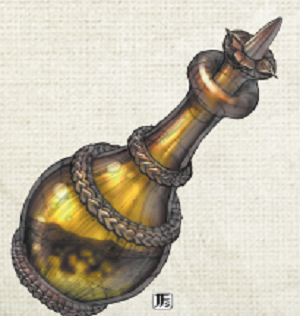 By the beginning of the Bane War, Hyphrates verged on a failed state. The wars against the Enochians (and possibly Fae intervention) had turned the land beyond the riverbeds into desert, and the merchants that controlled the government had turned to backstabbing, feuding over positions, and building their wealth abroad instead of aiding their population. Drug abuse was so endemic most of the population regularly used soporifics or hallucinogens of some kind, and the bureaucracy had grown so thick it could take years for messages to make their way to the top. As such, Hyphrates failed to respond to the invasion for years – until Hasani made his mistake. A minor bureaucrat who happened to be descended from the old Pharaonic line, Hasani lucked into a way to summon the Djinn. He wished for her to “return Hyphrates to its ancient glory”, and she complied – by raising the necropolis of Urukdria from the sands, its inhabitants brought back to unlife as mummies and led by an undead Memmon. Suddenly, Hyphrates turned from a potential supply center for Morden’s forces into a new theater, one its government and military proved unable to handle; while their merchant companies became a vital part of the logistics network, Hyphrates offered little to the war effort beyond that. Bit by bit, Memmon’s army took back its ancient lands. 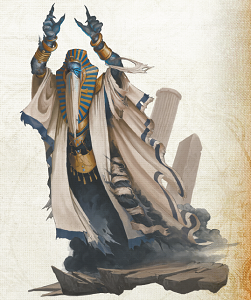 And then the Djinn disappeared with the Great Betrayal. While some of her army went rogue like the Crone’s had, Memmon took full control of the rest and resumed the conquest. Today more than half of Hyphrates lays under his control, and Consul Bikheris has proven unable to hold his forces back. Despite his pleas, the only group coming to Hyphrates’s aid is the Order of the Penitent. The Bishop in charge of the Penitent war effort, Luciano Tierno, will offer Witchmarked willing to fight with him more aid then they’ll find anywhere else in the continent, as long as they are willing to fight a losing battle for a fearful and suspicious populace. Next time we cover Manreia, Steppegrad, and Valkenholm, the former great powers of Morden, and their gruesome fates under the Witches. Mors Rattus posted:What do you want see next? I remember hearing something about vampire pirate conquistadors back in Fantasy. Did they make the transition?
|
|
|
|
Changed mind
MonsterEnvy fucked around with this message at 01:40 on Aug 17, 2020 |
|
|
|
Gloomspite Gitz, let the goblins shine!
|
|
|
|
Vampires are in Legions of Nagash. I don't recall if any vampire pirates get mentioned more than briefly.
|
|
|
|
Falconier111 posted:I remember hearing something about vampire pirate conquistadors back in Fantasy. Did they make the transition? They did not, but the Vampire Coast is a playable faction in some Total War: Warhammer II DLC that was released in late 2018, so they're not as forgotten as they could be.
|
|
|
|
Mors Rattus posted:Vampires are in Legions of Nagash. I don't recall if any vampire pirates get mentioned more than briefly. Break my loving heart. Them, then.
|
|
|
|
The wraith fleet has been mentioned in soulbound. Edit: Also changing my vote would like to do the Legions of Nagash, which is also one of the few pre 2e tomes. (Though made with 2e in mind.) MonsterEnvy fucked around with this message at 01:41 on Aug 17, 2020 |
|
|
|
Ghost Leviathan posted:So this whole thing is basically him having a crush on his boss? Assuming my memory of stuff I haven't gotten into for nigh unto 25 years or more holds true, "boss" is probably putting it strongly. I think the real deal is that he was moping around Dargaard Keep when she offered him the chance to grab the soul of Laurana, Tanis's girlfriend and a hot elf-girl. Along the way, Soth really admired Kitiara for being a tough (really hot) badass warrior chick. Admiration turned to obsession (as it's want to do for undead horrors) and the rest is history* *In the sense of being a confusing mish-mash of writers with differing takes on the situation. Falconier111 posted:
An edited mis-spelling. That said, Soth has numerous spell-like abilities (including the ability to drop a Fireball worthy of the most potent Fire masters). He has a 3 in 4 chance of simply ignoring any magic cast at him (including Bending powers most likely). Oh, and he's also undead. So, as an unliving horror he can't be, y'know drowned. So, yeah, all in all, he likely actually is more powerful than most versions of Katara.
|
|
|
|
 Buck Rogers XXVc: The 25th Century Vehicles: We Were Promised Jetpa- oh wait there they are NVM  We’ve seen Rocket Belts on some of the artwork for the game, and they’re a direct link to the history of Buck Rogers. In the first stories and comic strips, Buck and company all wore ‘gravity belts’, which let them jump and float through the air by turning dials. At some point in the strip rocket packs became the preferred mode of personal transportation. In XXVc, a rocket belt is a turbine and two pods which direct power from burning solid fuel pellets. It’s described as similar to the actually existing jet pack developed by Bell Labs. In practical terms, the belt costs 1000 credits, the fuel pellets cost 100 cr each, and the device can lift someone at 200 pounds at 20 feet per minute and last for about 30 minutes, all in Earth gravity. I guess you can do the math to work out the maximum limitations in other gravities and for other weights, but they point out that more often it’s used to make big jumps (yumps, if you will), lasting less than two minutes and moving at about 15 mph/1,000 feet per minute horizontally. There are two major limitations to the device- you need one hand to work the controls, so you can’t use two handed weapons while flying, and the fuel needs oxygen to ignite so it doesn’t work in a vacuum. To rocket through space without a whole ship, you need a Space Belt. This also costs 1,000 credits, and uses compressed gas. You only get 30 bursts per canister (canisters cost 20 credits apiece), but because of how space works- the whole lack of gravity and air resistance- a single thrust already sends you flying 120 feet per round, and the only way to stop yourself is to fire another burst in the opposite direction. Or you can get stopped by something, but if you’re going 200 or more feet per round when this happens you either save vs. falling or take damage (1d8, 2d8 if you’re going 400, 3d8 if you’re up to 600, etc.) I would assume the gas system doesn’t work in Earth gravity/an atmosphere but it’s not explicitly stated.  We also finally have flying cars, and while ground vehicles still exist they’re not statted here so who cares? A jetcar costs 35,000 credits and it’s about 15 feet long and carries two people plus 50 cubic feet of cargo, or just three people. It can go 100 mph flying at a steady altitude, and can go up at about 15 mph. Typical speed is more like 50 mph, and a single can of rocket fuel will last about three hours at that speed (and you can refuel in mid-air). There’s also a cheaper “skimmer” with no cargo space beyond a couple of fuel canisters and personal effects, can only rise two feet off the ground, and has 50 mph as a top speed- on the upside, it’s way more fuel efficient. Also it’s worth noting all those speeds are consistent whatever planet you’re on, because jetcars are manufactured to work in a specific environment. Finally there’s the Dragonfly, which is a one-man helicopter. Costing 15,00 credits, it can move up to 20 mph and is powered by an atomic battery lasting about 20 hours. This can’t be used in any environment where air pressure is below Earth’s, due to the aerodynamics of it. All three of these are more likely to be props/used for specific setpieces in an adventure than something the PCs obtain, but it’s nice to have the info here. And that FINALLY wraps up the Equipment book. There’s still a little bit to get out of the box set, though. Remember those flash cards I mentioned? Well I’m gonna scan some of ‘em and look over the info they provide. Coming up, we’ll meet some of the big-shot NPCs of the setting!
|
|
|
|
I imagine if you run out of maneuvering juice in space you just go sailing comically off into the cosmic hell of nothingness.
|
|
|
|
Mors Rattus posted:An Arkanaut Ironclad is the heaviest warship the Kharadron have devised, a [b]massive and intimidating ship]/b] of the line with enough guns to level a city. (Assuming the city doesn't defend itself, anyway.) In the grand fashion of GW vehicle design, they certainly don't have the space to hold their supposed troop compliment (or much anything else, really). Observe: The Ironclad:  Carrying capacity: 25 fat sky capitalists, lol. Massive and intimidating indeed!  Carrying capacity: 15 steampunk cosplayer dorfs  Carrying capacity: look, it barely holds Such are the perils of designing models for a 28mm mass combat game wile avoiding a $ForgeWorld price. JcDent fucked around with this message at 15:49 on Aug 17, 2020 |
|
|
|
You can take an optional thing for the Gunhauler to somehow fit five more guys inside it. Mind you, it’s not a great idea, because you have a limited number of said optional things, but somehow, if you add a cargo hold, you can stuff five dwarves in.
|
|
|
|
Anyways, do Cities of Sigmar
|
|
|
|
To earn their robes, initiates to the Order of High Sorcery must face The Deck of Encounters Set Two Part 39: The Deck of Hippogriffs and Hydras 197: Into the Unknown Lands A baron approaches the PCs about clearing dangers out of an area where he’s building his manor house. “Exploration of the area is routine,” so that’s boring, until there are some flying creatures overhead - more and more gather if the PCs don’t attack them, then all land in front of the PCs. It’s a pack of 16 hippogriffs. “They send forth a single representative who wants to communicate but cannot unless the PCs use magic.” Apparently their lands overlap the area the baron is claiming. Delicate negotiations may be required. Wait, hippogriffs are sapient? Their Monstrous Compendium entry talks about how you can “domesticate” them if you catch them young enough and train them. But if you throw that out and just make them people as this card suggests, then it's a more interesting quest than some. 198: Spell Components The PCs are approached by a wizard friend who is dying of old age, and wants them to fetch a fungus from distant mountains so he can make a potion in order to hubristically defy the will of the gods. He knows exactly where the cavern is where the fungus grows. They find a little but need more, and as they delve deeper there’s a weird musty smell that agitates animals. It’s because this is the lair of ten hook horrors, who will attack them when they find the large fungus patch. Pretty boring! But fine, I’ll take it as a quest. Drop this into some underdark style dungeon so the PCs have to do some exploration and stuff. 199: Fire and Water “The PCs have been sold a treasure map to a known dungeon entrance with a listing of the treasures inside.” ...What? I have… so many questions. But let’s set them aside for now. The entrance is in the middle of a swamp, underneath an altar flanked by ruined pillars. The stone is all scorched. A pryohydra attacks as they approach it. It dines on adventurers who try to enter the dungeon. I assume hydras are like crocodiles, and only need to eat once in a blue moon. I’m fine with having this be the destination of a treasure map that the PCs find somewhere (maybe without the treasure listing). But it doesn’t help me much in a deck of random encounters. So quest, I suppose. 200: Too Many Heads The PCs are in a work-hard-party-hard mining town. After midnight an alarm goes off and everyone sobers up instantly - it’s the cave-in signal. But it’s not actually a cave-in, it turns out, as the crowd gathers near the mine entrance - instead, the miners dug too greedily and too deep, and woke up a Lernaean hydra, which shortly busts out of the mine entrance, showering rocks everywhere. Everyone screams and flees. Interestingly, the hydra’s behavior is not specified - the card doesn’t say that it attacks, or is hungry, or whatever. Maybe you can just let it wander off or something? Anyway it’s fine, any given mountain town probably has some mining going on. Keep. 201: What You Can’t See This is an odd one because it seems to assume the PCs are thieves. Like, as a group or something. We get background on this rich merchant, Kelnit, who leaves town for a couple of days. “If the PCs don’t take the bait, they are approached by several townfolk out for a little revenge on the merchant. They offer the PCs half the take, providing they can get away with it.” Gee, we really want the PCs to burglarize this shop, huh? What’s inside? Well, mostly a chest with 5000 gp and an invisible stalker (created by a contingency spell, which was very important info to know). I mean, sure, keep this on-hand if the thief is like “I want to go rob some rich rear end in a top hat!” But it doesn’t need to be in a deck of random encounters. Quest.
|
|
|
|
The Illithiad It's time for a review of yet another 2e AD&D supplement, in this case the Illithiad and its short chain of associated adventures: A Darkness Gathering, Masters of Eternal Night and Dawn of the Overmind. As the name suggests, the Illithiad is all about Illithids(colloquially, "Mind Flayers"). It and its associated adventure chain are part of a short-ish series of AD&D supplements called "Monstrous Arcana," intended to add more depth and information about some more-or-less iconic AD&D creatures: Beholders(I, Tyrant), Sahuagin(The Sea Devils) and Illithids(The Illithiad). Personally I've always had a fondness for Illithids, so their part of the trilogy is the one that I'm most familiar with. The framing device for the Illithiad is having it be the collected journals of Strom Wakeman, a merchant who becomes obsessed with learning more about Illithids after one of his caravans taking a shortcut through a cave was ambushed by an Illithid and almost killed to the last man, with only himself and a handful others surviving. Strom has since vanished, possibly being assassinated by the Illithids. 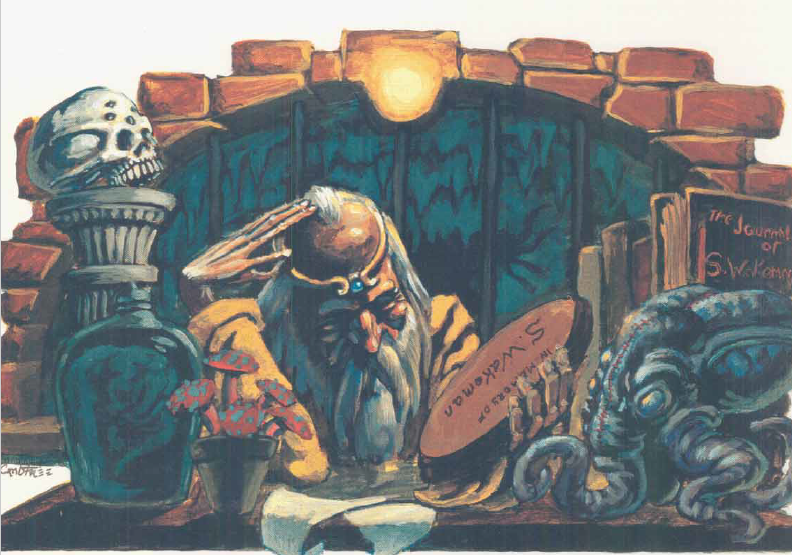 Now, to make this comprehensible to people who don't play D&D, or don't play it much, let's answer what they're probably wondering: "What the gently caress is an Illithid?" The short answer is: "One of the most sadistic non-unique enemy types you can drop on a party that doesn't involve destroying their gear, draining their stats or eating their levels." The slighty longer answer is that they are, per the Illithiad, kind of like the Skaven of D&D. In many ways they have the same psychological hang-ups of: "I should be in charge of reality. What's with all these loser mammals running around not letting me be in charge of reality? I should be their master." And then promptly initiating some sort of boondoggle supervillain scheme that ends up being foiled by adventurers, Gith or both. They're played a lot less for comedy than the Skaven, however, and more for horror, so they don't exactly have a Thanquol running around. PC's are meant to be grossed out and disturbed when dealing with them. And the really long, proper answer involves actually describing them. So let's begin with their biology!  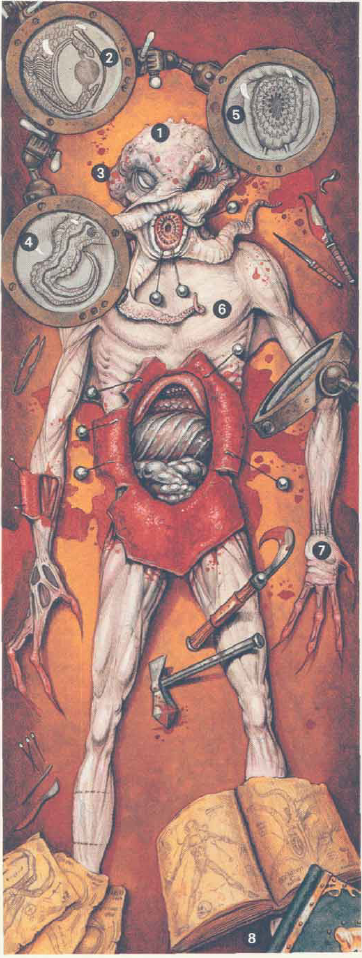 Biology You get Illithids from Illithid larvae(tadpoles) being implanted into the brains of adult, human-sized creatures(they need to be mammals, and if they're too small or too large the tadpole won't grow properly). They then lose all gender characteristics and turn into pale, purplish people with squids for heads that are nourished exclusively by the brains of sapient creatures. The tentacles are used for holding on to the heads of said sapients so they can munch down. Additionally they're covered in gross anti-magic mucous and see pretty much exclusively in Predator-vision, i.e. heat vision(though they can also sense nearby living minds). Occasionally aspects of the former owner's personality will remain with them(small personality tics), but Illithids have an urban legend of some of their number being slowly completely converted by these personality fragments, including one known as THE ADVERSARY who lurks within their society and sabotages their plans. In truth this has never in recorded Illithid history actually happened, but having lesser species bits left in you is still considered gauche and Illithids usually try to excise these with psionic surgery, because otherwise they may end up social pariahs, ejected from their society or even outright killed if their inherited personality tics are too notable. A small number of times over their 100+ year lifespans they produce a clutch of tadpoles which are deposited in the community's Elder Brain pool where they function as food for the brain and eventually mature to be old enough for implantation into a sapient. If a tadpole escapes the pool or gets left behind when a community is destroyed or abandoned, it'll sometimes feed on rats and other cave vermin, slowly becoming larger and larger until it's a dragon-sized, sapient worm that dissolves living creatures with feeding enzymes and then slurps them up. That's called a Neothelid. The only real Illithid "subspecies" are the Ulitharids. Randomly one out of two thousand or so Illithids are extra large and have an extra pair of tentacles for grabbing people's heads and eating their brains. The third "life stage" beyond tadpole and adult Illithid/Ulitharid is the Elder Brain. It's made from the brains of dead Illithids. They're hucked into a central pool where the tadpoles are also kept. When enough brains are floating around in there, their personalities merge and they're quickened into an Elder Brain. Further added brains simply add to its knowledge and powers, not its personality(though the Illithids have been fooled by the Elder brains into thinking that their personalities will survive within the Elder Brain). Elder Brains are immensely psionically powerful, scouring their community with a powerful radar, relaying information and functioning as the community's store of knowledge. In fact, the Elder Brains are often the only store of some kinds of knowledge, like history, thus they're exceptionally well-suited to manipulate the Illithids of their society and keep them in line, preventing them from engaging in some sort of wrong-think perhaps not involving the total subjugation of the world.  Tadpoles aren't too scary, and Elder Brains suffer from the weakness of being large, immobile targets that can't do much if they're not backed up by the rest of the community(but if they are, they can be a real force multiplier). But your average Illithid is a save-or-die for the entire party. They can't turn you to stone, stop your heart or disintegrate you, but every single Illithid has a conical Mind Blast attack that forces every victim hit by it to save vs Wands or be paralyzed for 3d4 rounds, more than enough time for even a single Illithid to eat the entire party's brains if everyone flubs their save. The only way to avoid this is to be lucky, brainless or wearing a specialized kind of tinfoil hat introduced in Masters of Eternal Night. Sniping them at distance with magic doesn't work, mind you, because of their sky-high Magic Resistance percentage(in 2e, unlike in later editions, Magic Resistance is just a flat percentile chance to no-sell a spell cast at you, no matter whether it's a Wish from Zeus or a Fireball from the party mage). Being brainless is, in general, a very effective move against Illithids, because they can't see things that don't have brains or radiate heat until they're right up in their grill. So stuff like golems and the undead are terrifying to them, and an Illithid that doesn't have the support of a bunch of slaves or thralls to spot those kinds of threats for them is in an exceptionally scary situation. Daylight is another bane of theirs, firstly it prevents them from using their heat vision to see very far and secondly it dries up their protective mucous layer, making them susceptible to magic and eventually slowly killing them. In much the same way that they use thralls to compensate for their weak senses, they use psionic power armor to protect themselves when forced to venture on to the surface. quote:Ah, the accursed sunlight, with its searing heat and sight-dissolving radiations! It is only through the wanton energy of such orbs that thrall races thrive and grow strong.  pictured: steve the illithid being scared of skeletons Previously, you'd likely be spared dealing with Illithids because no GM with half a brain left would want to interact with the 2e AD&D psionics subsystems if he could help it, but the Illithiad helpfully shows you how to convert Illithids to non-psionic variants, replacing their brain magic with equivalent arcane spells. The book does, however, give them some funny new psionics like being able to turn off the part of someone's brain stem that makes breathing reflexive, forcing them to consciously breathe for a month(i.e. NEVER loving SLEEP) unless they're hit with very powerful healing magic. They can also make Temporal Jam(okay it's called "quintessence" but it's literally solidified time used to put things into stasis and it has the consistency of jam, so to me it's Temporal Jam. Put it on your sandwiches), make psionic artifact items and, grimly, make a target deeply desire to kill themselves so that after a week or so unless they make their save, they just attempt to end their life in the easiest way they can(throwing themselves off a cliff, stabbing themselves, etc.). Thankfully the nastier brain-rending powers can be interrupted by killing the Illithid maintaining them. Psychology/Society Psychologically, Illithids are in some ways similar to other sapients. They've got hopes, dreams, friends, needs, fears, etc., but in some ways they're also starkly different. The primary differences are, as noted, that firstly they consider anything not an Illithid to be an eventual meal or slaves, secondly they consider themselves destined to eventually rule over everything in the universe. quote:The universe contains a myriad of potentialthralls that live, grow, and build without any guidance whatsoever! Such an untidy state of affairs demands the mastery of a superior race to restore order. After all, thralls require supervision, and only the illithid race can provide that service to others across the width and breadth of the multiverse. If illithids do not take up this important task, they deny their destiny! Of course, as noted, this isn't an in-born attitude, but one that Illithids are raised with and trained in. It would be difficult to see how an Illithid that didn't subscribe to this view could survive without finding some novel means of sustenance, but it's technically plausible. Lastly, Illithids have a deep loathing of suns and daylight, and one of their perpetual goals is to eventually snuff out all suns, or at least darken them to a permanent twilight, so they can haunt the surface unopposed. quote:The emotion Illithids most often experience is frustration, as their racial goals of domination and mastery remain unrealized. Such a constant undertow of discontent subtly colors every other emotion, thought, and action. Thus, frustration remains one of the mind flayers' defining emotions With writing like this, I hope you guys can see why I compare the Illithids to Skaven.  The text also seems to imply that Illithids often have closer relationships with their thralls than other Illithids, because of the intense inter-Illithid competition present at most times(they believe that their ranking within the actually-not-existing Elder Brain hivemind is defined by how well they do in life), and outright states that Illithids tend to become moody, depressed and eventually wither away without the company of thralls. This could be taken as either Illithids having a fundamental need for companionship or as their being useless layabouts at anything not involving conquering and eventually drowning in their own unwashed clothes and dishes if left by themselves. quote:An illithid community views any individual unable to secure mental slaves as flawed. Usually, an illithid in such an untenable situation flees its community in shame. Bereft of the constant companionship offered by thralls, these poor mind flayers either die quietly or lose their faculties to loneliness. When dealing with each other, most if not all Illithids eventually join a Creed, which tends to be somewhere between a guild and a political party. A guild in the sense that each Creed has a section of skills it focuses on and develops, a political party in the sense that each Creed tends to also have a specific view of the most important things about Illithid society/conquest and how to further it. Like you've got the Possessors, who are Illithid bankers believing that economics are the most important tool that Illithids have, building elaborate treasure vaults and increasing their hoards. The Tamers are the local Hawks, all about classic armed warfare and tactics. The Nourishers feel like the thralls are the most important resource the Illithids have, and seek to strengthen and safeguard them. The Abysmals insist that the proper way to conquer the world is to terrify the thrall races, and thus ensures that every Illithid undertaking they're invested in is full of as much unwarranted, edgy horror as possible. The Darkeners focus on the boondoggle plans for extinquishing suns. The Arisers focus on building power armor and dampsuits so the Illithids can march on to the surface even in full sunlight. And so on.  funniest thing I ever saw! we turned him into an illithid and we called him illithid Rick! Appropriately enough, Illithids also have their own entertainments. Some of them are analogous to human entertainment, like music(often played on the Bonethriven, which is like bagpipes made out of, well, bones) and gladiatorial combat(albeit between fighters being psionically puppeteered like pokemon), while others, like "performance eating"(artistic brain-eating where the performer is psionically linked with the audience so they can taste and feel what the performer feels) don't quite. Religion-wise, Illithids worship Ilsensine and, formerly, Maanzecorian. Maanzecorian got ganked by Orcus a while back, which is a shame, because having two competing religions would help add a bit of life to the Illithids in the religious sense. History The origin of Illithids is left intentionally vague, to allow GM's to slot them into their gameworlds in an appropriate way. It's suggested that they might have been explorers into the Far Realms or the time before time which were twisted and warped by those regions into something unrecognizable(which would account for their tadpoles being so compatible with human-sized sapient mammals), that they were travellers from some other universe that travelled unfathomably far and crashed on a known world, or that they were created by a spiteful Ilsensine at the dawn of time alongside the other races. What's known as fact, though, is that the current Illithids are far fallen from where their empires were once. At the apex of their power, they had suborned close to the entire Prime Material plane(darkening thousands if not millions of crystal spheres by tampering with their suns) and were laying siege to multiple Outer Planes, presenting such a threat that even the Blood War was put on hold to try and push them back with all available forces. But nonetheless, they slowly and inexorably ground onwards. They had the occasional slave revolt, but nothing they couldn't happen, until the slave leader Gith taught her troops how to resist Illithid psionic influence and even how to develop their own psionic powers. This is what hosed them up, as the Gith(who eventually became Githzerai and Githyanki), knew the Illithids intimately and managed to destabilize them enough that the Illithid empire collapsed. Combined with their reliance on Elder Brains as stores of knowledge, Illithids lost a lot of what made them powerful, like guaranteed ways of extinguishing suns. Aside from that, their history would need to be adjusted to each given campaign world, but it seems a general given that any Illithids present are lost remnants of their ancient empire, driven underground once the sun kicked in again by their ungrateful thralls. For those who don't remember them, Githzerai primarily live in Limbo under the rule of their Sorcerer-King and send Rrakma bands to hunt Illithids across the planes, while Githyanki live in the Astral and do much the same, but they've somehow managed to make a deal with Tiamat which means they get red dragons as mounts and are thus considerably scarier. 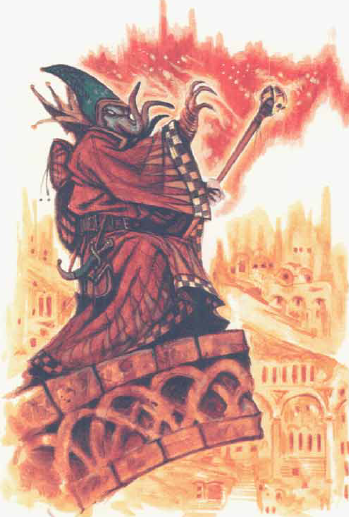 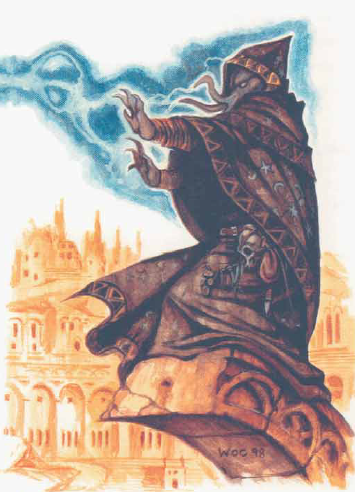 in the book these are on opposite pages and their zappy bolts touch where the pages do, it's kinda cool  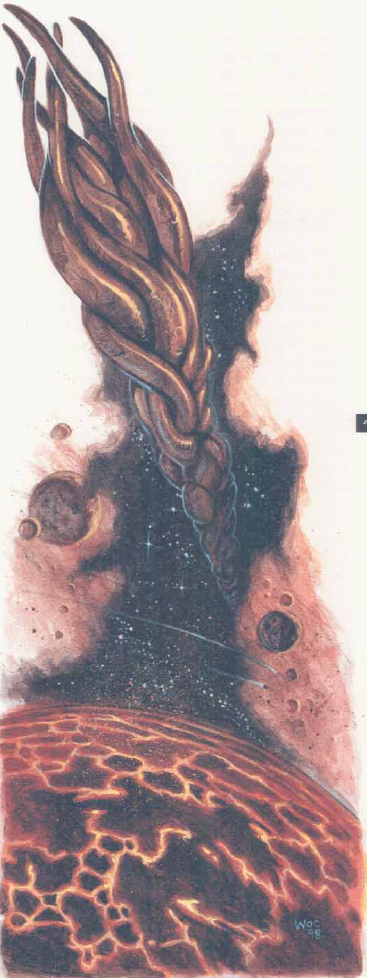 have I mentioned that most of the art in this book is rad as gently caress? Mechanics Mechanically, assuming you ignored the ability to eat brains after landing successive hits with their tentacles to pin their prey, their mind blast, their psionics and their sky-high magic resistance, an Illithid is equal in combat roughly to a lightly-armored 9th-level Fighter, which means they are not loving around. If you give them a sword, they can wreck your day. Probably the best way to deal with them is to either flood their settlement with mindless undead and elementals from range or to get the local dwarves to flood the cave network with magma until nothing survives. Everything they do, an Ulitharid does better and more scarily, they even up the already insane 90% magic resistance to 95% and, again, ignoring all special powers and defenses are roughly equal to an 11th-level Fighter. Alhoons are heretic Illithids who have become Liches instead of merging with the Elder Brain. Aside from being undead and never in an Illithid community, they're more or less just normal Illithids with a spellbook. Remembering the Mind Blast, I'd say each Illithid is on average worth two level 9 Fighters, as they'll pass their save literally 50% of the time and considering that they actually wear armor will probably win a one-on-one fight if they resist the Mind Blast. Upgraded to certainly if they're wrestling-specialized Combat & Tactics Fighters, as they're the resounding kings of one-on-one combat and could almost certainly tie an Illithid into a knot and kick them down the stairs in a round or two. Mages and Clerics have to get creative to participate in the fight, since they can't directly blast the Mind Flayers(90% magic resistance and all), while rogues similarly need to get creative to dodge the psi-radar and heat vision. Still, more than most combat in D&D it's very much a random roll of the dice. Does everyone get KO'd by the Mind Blast in round one? TPK. Does the Mind Flayer land all of its tentacles on Steve's fighter in one round? Dead PC. At least other fights might give you a few rounds of warning that someone's about to eat poo poo, offering you a chance for them to pull back, be healed, etc. Without the bullshit Mind Blast attack to start off every fight, Illithids might actually be an interesting tactical challenge since the wizard can't just roll up and cast Fireball or Magic Missile over and over to resolve it, and their non-standard senses give the players something new to work with. In any case, this is the end of the information presented in the Illithiad(except for the mechanical stuff like the detailed rundown of new Illithid powers, stat sheets, an example community and the list of Illithid tools.).   Illithid power armor/dampsuit 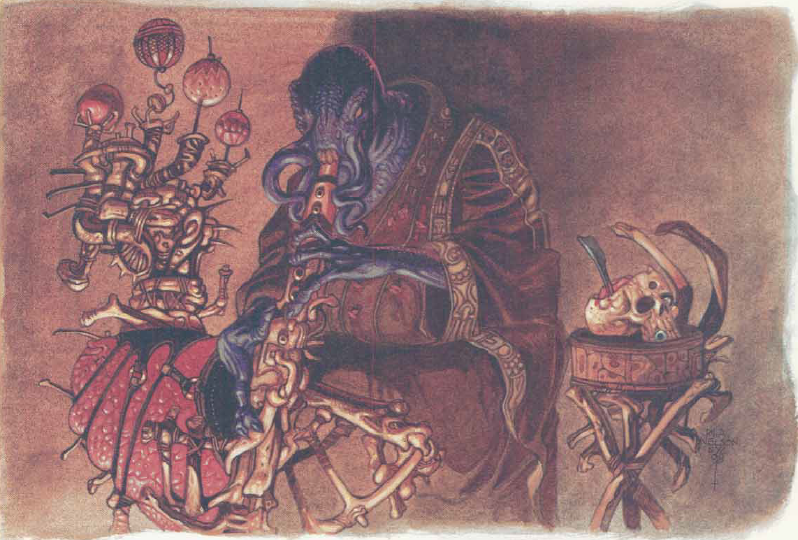 stop asking me to play freebird, steve Hopefully anyone reading this now has a decent idea of what Illithids are and how scary they can be to fight, and you'll have some background for when we start on... A DARKNESS GATHERING. PurpleXVI fucked around with this message at 21:05 on Aug 17, 2020 |
|
|
|
JcDent posted:In the grand fashion of GW vehicle design, they certainly don't have the space to hold their supposed troop compliment (or much anything else, really). Observe: Yeah they are bigger in lore then they are in Model. PurpleXVI posted:The Illithiad Huh other then the cover they are pretty much using their modern designs that is interesting.
|
|
|
|
Illithids reminds me of the Ravenloft adventure Thoughts of Darkness. What a poo poo show that adventure was. They managed to up the dangers of mind-flayers by adding vampirism to them and forcing you to fight a small group of them. On the positive side, I guess level drain isn't that big a deal when any melee hit is basically guaranteed death because of brain-eating. edit: I used to have that adventure, but think I lost it somehow. If there's any interest I could try to do another deep dive review of that one, I have some time on my hand these days. Ithle01 fucked around with this message at 18:07 on Aug 17, 2020 |
|
|
|
 Chapter  : Dev Interview : Dev InterviewI did get a response from CroatianAlzheimers about Accursed! I’ve excised some of the juicier gossip and such and marked the excisions with ellipses, as is common practice on many oral histories. I posted:I’ve been told you are one of the folks who developed Accursed. If so, I’d like to formally invite you to drop by the Fatal and Friends thread, where I’ve begun a long-form review of it and would like to hear your thoughts. CroatianAlzheimers posted:Hey! Yeah, that's me. I'm Jason Marker, I'm legit shocked that other goon remembered my handle and that I worked on this. Man, I haven't thought about Accursed for years. I did a couple of the Accursed types/Countries (Steppengrad, Hebron, a third one I don't recall (either "totally not Egypt" or "totally not Spain"), and one of the countries in the second book), I came up with the Mongremen and how they work, and I did the weapons and equipment and (I believe) anything that has to do with ships and the sea. The project was Ross Watson's... I fell out with Ross during production of this book, got tired of the setting, and only worked on the sourcebook (World of Morden) out of a sense of duty to John Dunn, the publisher and my good friend. I've never run a game of Accursed... Falconier111 fucked around with this message at 23:18 on Aug 17, 2020 |
|
|
|
Dallbun posted:To earn their robes, initiates to the Order of High Sorcery must face According to my newly purchased AD&D 2nd ed Monstrous Compendium, Hippogriffs are listed as having Semi (2-4) Int. Of course, there's no reason that these particular Hippographs can't simply be "geniuses" due to some genetic/environmental quirk so you can have your people and ride (the normal dumber versions of) them later. Hell, maybe with the idea that these 'griffs don't care that much. Kind of like when Donald Duck would sometimes go duck hunting.
|
|
|
|
Ok, Ilithids rule. ...so basically, DnD is OK when it's not Faerun/Greyhawk/Krynn and you're not using the official rules. E: could totally see Ilithids as some xenos empire exterminated during the Great Crusade.
|
|
|
|
The Imperium of Man could possibly figure out some crazy type of extra lobotomized Murder Servitor that the squidheads won't see until it's right in front of them. And there would definitely be inquisitorial kill teams with some psychic protection hunting them down too.
|
|
|
|
JcDent posted:E: could totally see Ilithids as some xenos empire exterminated during the Great Crusade. They basically are. The Rangdan Xenocide that almost destroyed the early Imperium at the dawn of the Great Crusade were basically Illithids, complete with psi-titans.
|
|
|
|
By popular demand posted:The Imperium of Man could possibly figure out some crazy type of extra lobotomized Murder Servitor that the squidheads won't see until it's right in front of them. Great Crusade predates Inquisition, though they did, uh, solve one alien species that fed on humans by making all the local pops poisonous. Cythereal posted:They basically are. The Rangdan Xenocide that almost destroyed the early Imperium at the dawn of the Great Crusade were basically Illithids, complete with psi-titans. Huh, never knew they detailed those in any way.
|
|
|
|
Illithids as an enemy are actually very boring most of the time because fights have a 'save or die' component on round one when you have to avoid being stunned for 3d4 rounds, which is basically an entire fight. Illithids often have spell-casting powers to supplement this and that's when things get interesting, but the generic illithid is a fight handled with one saving throw. And their ridiculous magic resistance doesn't help make the fights anymore interesting.
|
|
|
|
Ithle01 posted:Illithids as an enemy are actually very boring most of the time because fights have a 'save or die' component on round one when you have to avoid being stunned for 3d4 rounds, which is basically an entire fight. Illithids often have spell-casting powers to supplement this and that's when things get interesting, but the generic illithid is a fight handled with one saving throw. And their ridiculous magic resistance doesn't help make the fights anymore interesting. Extremely. Back in Baldur's Gate 2, you either won or you lost basically immediately, because if you were shielded or made the saves they were easy to slice in half.
|
|
|
|
They should be better to deal with in BG III cause the save to avoid being stunned is round by round.
|
|
|
|
Playtest of the dwarf fortress ANGUISHEDWIRES from How to Host a Dungeon is scheduled for later this week. Once that's wrapped I'll finish off the final update. Thinking of doing a quick read through of the Mothership corebook in the interim.PurpleXVI posted:The Illithiad I had an idea a while back for a "megagame" set aboard an Illithid Nautilus ship in deep space. You have a bunch of tables, each set aboard a different part of the ship, each focused on a different subsystem. So one group does a spacewalk on the hull, which gets strafed periodically by Red Dragons because the ship is currently in a space battle with the Gith. And another group hits the flooded reactor complex, at the same time as an Aboleth gates in to try and steal the magic fuel rods. Another group tries to pillage the library before the Illithids can grind up the memory brains to destroy all the sensitive data. Since Illithids have thralls taken from other species, you could populate the encounters with whatever monster mash you like. Then at the end there's a battle with the control brain for the ship's bridge, with challenges that depend on how well everyone did in the segments leading up to it. I didn't end up doing anything with the idea, because I don't actually have that much interest in the main-line D&D editions. Plus you'd have to make a big nautilus model with removable cross sections, dangle it from the ceiling on a bunch of fishing line, etc.
|
|
|
|

|
| # ? Apr 26, 2024 03:15 |
|
 Chapter 1: The Land of Morden (Manreia, Steppegrad, and Valkenholm) 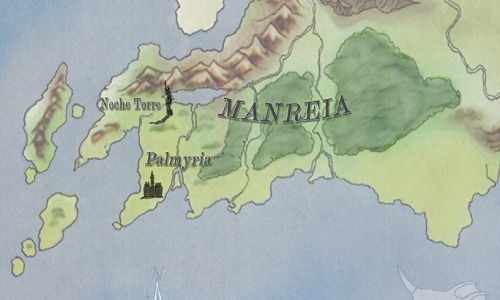 Manreia is the most technologically advanced society in Morden; its social system, in which the only way for the thoroughly-subjugated landbound peasants and escape control is to be accredited as tradesmen, incentivizes development. It is, after all, the place where gunpowder was first invented, and it houses the only train network in the world. With their basic needs supplied by the stablest climate and most fertile farmland in the world, the Manreians, led by their Council of Lords, have dominated Morden’s economy for centuries. So when the Bane War broke out, Manreia quickly became the logistical heart of the war effort. While it sent tens of thousands of soldiers to the front, Manreia’s greatest contributions were in food, arms, and supplies; too far away from the Grand Coven to attack it in force, it remained the only nation untouched by the ravages of war. For the most part. Their greatest inventor,  Manreia is by far the healthiest and safest nation in modern Morden. It is also firmly under the control of Lord Warlock Hesterly. The capital, Palmyria, still houses the Council of Lords; but the governing body of the country has become a powerless advisory board for their new ruler. Manreia’s craftsman system is still intact, and the flood of refugees into the safest land in Morden brought with it some of the finest artisans in the continent; but the guilds initiated too many journeymen to keep production up and the promissory notes the government issued to them are worth nothing now, leaving even the finest of foreign craftsman stuck without sponsors in an oversaturated market. While the native population has shrunk considerably due to losses in the war, the refugees have brought just as many people back it to farm the still-productive land; but these refugees fled to keep their freedom and have no intention of throwing it away toil as landbound serfs. The whole country functions, but it is just as firmly under Witch control as the rest of the continent. Manreia is a symbol of either the dark present or bright future. Some see it as the recipient of unfair good luck, having avoided the savaging the rest of Morden suffered and submitted peacefully in a final act of cowardice and betrayal. To others, it represents hope that the Witches may be overthrown; for all its weaknesses, Manreia it still the wealthiest and strongest nation in Morden and just might serve as the nucleus in the fight for freedom. 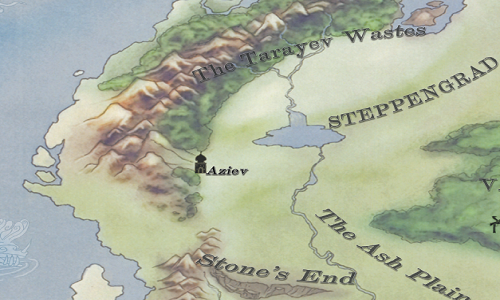 Steppegrad was once the mightiest nation in Morden. Ruled by autocrats and devoted to the church, Steppegrad was at once deeply inhospitable, militarily mighty, desperately poor, and culturally sophisticated. Every Gradniki lived in an elaborate social system prizing communal saunas and afternoon tea ceremonies, building large families and working with their neighbors. Religion held nearly as much importance in their lives as their families; every village, no matter how small, had a priest charged with helping them follow the unique, locally-influenced, nature or Virgin of their religion they call Orthodox Enochianism [  ]. A deeply fatalistic people, Gradniki balanced their belief that everything is preordained with a desire to live life to the fullest right now, creating a culture at once greatly dour and joyous that birthed some of the greatest artists and thinkers in Morden’s history. The Kainenites may be better musicians, but the Gradniki are definitely better composers. ]. A deeply fatalistic people, Gradniki balanced their belief that everything is preordained with a desire to live life to the fullest right now, creating a culture at once greatly dour and joyous that birthed some of the greatest artists and thinkers in Morden’s history. The Kainenites may be better musicians, but the Gradniki are definitely better composers. When the Grand Coven burned through the Outlands and reached the Steppegrad border, the nation as one rose to muster a massive army to fight their enemy, lead by none other than Baba Yaga herself. At first, even the partially trained volunteers found their enemies easy to defeat, and soon the Army one victory after victory. Except to the victories wouldn’t stop coming, because Baba Yaga’s forces wouldn’t stop coming, and even the mild losses the Gradniki suffered built until they found themselves driven back. Plagues and famine stalked the land, products of Baba Yaga’s magic; soldiers died in droves. In desperation to protect their nation just a little longer, the Gradniki switched to defensive warfare digging trenches and turning cities into fortresses; they slowed down the advance and were driven back slightly more gradually. Even Aziev, the capital city and one of the greatest in Morden, was sacrificed to trap an enemy army within as it burned. By the final defeat, the whole Empire lay in ruins. Modern Steppegrad barely resembles its former self. It lost more citizens numerically and proportionally that any other nation. With their villages destroyed, its people live by hunting in the woods and gathering berries in hopes of avoiding starvation. Only in the ruins of Aziev, where Baba Yaga has propped up a puppet Czar and theoretical government, can Gradniki find enough food to eat, and even then supply chains frequently break down. Almost every aspect of Gradniki’s culture has been lost. While hope remains – a few scraps of the Army remain active, many of Baba Yaga’s Accursed have turned against her – for the foreseeable future Steppegrad may as well be dead.  Valkenholm, on the other hand, at first appears to have survived the Bane War just fine. First settled by Gradniki centuries ago, the Valkenfolk broke free when Steppengrad’s rule grew intolerably explicated and formed their own, new nation; while it elevated its own nobility, it also set up a House of Commons to ensure representation for its people. Between its relative egalitarianism and thriving economy brought by a position in the most productive woods and mines in Morden and along the Scythe River, one of the largest in the continent, Valkenholm grew into arguably the region’s most prominent nation. In its time it was famous for its productivity and sophisticated culture, epitomized by several knightly orders and the largest Enochian Cathedral in the world. And on his throne sat the Hightower kings, descendants of the peasant that led the initial uprising and some of the greatest leaders in Morden. So when the Grand Coven struck through the Outlands, the king of Valkenholm, Stephen Hightower II, took charge and organized the alliance that pitted itself against the invaders. Valkenholm was unprepared and struggled at first, but its strategic position, easy access to supplies through the Scythe, and defensible forests made it an anchor of the war effort; even while Steppegrad collapsed, Hebron fell under siege, Hyphrates floundered, and Caer Kainen fell silent, Valkenholm successfully held the line. The last one proved their undoing. Stephen had not realized just what the Morrigan was up to in his eastern neighbor, so when she sent hordes of cauldronborn west into his unprotected flank, they took him by surprise and fatally disrupted his war plans. With the fall of Valkenholm more likely every day and little hope of relief, Stephen set up and executed the Great Betrayal – leaving his country open to occupation. 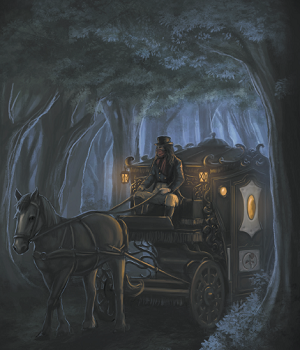 Today, boats still sail up and down the Scythe like they always have; woodsman harvest lumber and burghers run their companies just like they used to. But while Steppegrad’s and Cairn Kainen’s cultures were destroyed and Hebron’s inverted, no nation in Morden has had its culture hollowed out like Valkenholm. Countess Sanguinara, the Blood Witch, rules from the former royal seat in Kulidar, cultivating a court filled with convoluted plots and murderous rivals for her own amusement. Her vampires stalk the land and vanish people in the night; Banes prey on outlying villages and tribes of intelligent leeches hide in the swamps. The Redhawk Order, formerly tasked with patrolling the borders, is now a nest of vampiric Knights that enforce her decrees, and the mysterious Watch hunts down and executes dissenters. The fear Sanguinara brought with her has completely overtaken everything Valken society values. Seriously, the Culture and Government sections for every other nation cover what life was like before the War, but here it just covers how much everything sucks right now. A few parts of Valkenholm lie outside her reach. She has deliberately refrained from interfering with the Enochian Church; she spins it as a gesture of her mercy and generosity. She allows them to operate unimpeded as long as they don’t offend her, which they don’t – usually. Within her court, as much as she enjoys manipulating her courtiers, she cannot know every plot they circulate – including those to remove her. And then most of her Accursed, the Dhampir, have slipped her grasp, and they have every chance of developing enough political acumen themselves to one day bring her down.  Speaking of which. I never thought I’d say this, but I’m getting tired of writing all this fluff. I can barely remember the last time I made a character and that just feels wrong. In theory, I still have another post’s worth of setting description to work through before even beginning character creation, but you actually know everything you need right now to produce character concepts. So here’s how this is going to work. There are eight kinds of Accursed players can pick from:
So give me a couple character ideas! Keep in mind that while most Accursed created by the ruler of the territory come from that territory, not all do, and that all Accursed were created from people the Witches caught except for Mummies (who are undead nobility, though they pass their curse onto anyone who kills them). Falconier111 fucked around with this message at 01:46 on Aug 20, 2020 |
|
|































